

|
It's not an easy task to assemble a waterwheel, especially since it has to be erected in the continously streaming water of the river: Many helping hands are necessary -as well as special knowledge- to convert a heap of wooden parts into a working machine! On this page, the erection of a waterwheel is described with the help of some photographs. |
 |
Inserting axis, spokes and outer rims In the base (»Radstatt«), a thick tree stem (»Wellenbaum«) is inserted as an axis. The radial spokes (»Radarme«) are then fastened with wooden wedges. The spokes themselves hold the outer wheel rims, the so called »Krümmlinge« crafted from stems of abnormally grown trees. All strap-joints and bolts are made of wood entirely! |
Mounting the buckets (»Kümpfe«) 10 liters of water are the typical capacity of one of the wooden buckets, 26 of which are needed for either side of the wheel. In most cases, a single side of buckets is enough: only one of the vintage wheels carries two separate rows of buckets. Even here, all parts are made entirely of wood with the exception of the three stabilizing metal bands slung around each bucket... |
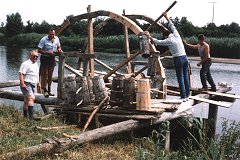 |
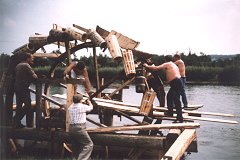 |
Inserting the pusher planks Now things are inreasingly becoming difficult, since the river is starting to push and turn the wheel without any mercy as soon as the first horizontal planks are reaching the waterline! Several volunteers and many rods pushed through the spokes are necessary to stop the wheel again and again during the assembly process. |
Fixing the dam (»Flügel«, i.e. »wings«) In order to assure sufficent turning power at any time, the slow-flowing water of the river Regnitz has to be directed in the correct angle of attack towards the wheel by a row of planks mounted under the waterline. Work in the shallow water seems to be an easy task, but don't be fooled by the first impression: The stream of water is never stopping and the ground is muddy... |
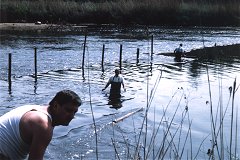 |
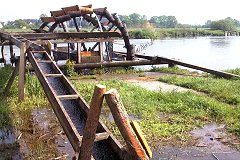 |
Erecting the wooden channel As soon as the wheel is running continously, it lifts and transports one bucket after the other of warm, nourishable water from the river's surface. A large »bathtub« catches the water spilled by the buckets on the zenith of their move, leading it through a channel of rough planks right into the digged channels of the farmland. The amount of water wasted by leaks is neglegible. |
It runs, and runs, and runs... Although working day and night without stopping, a vintage water wheel needs amazingly little attention and service, as long as it is not blocked or damaged by larger pieces of wreckage or other man made things floating down the river. The axis is lubricated by dripping water, and besides that there are no moving parts. Look at a device made from all natural materials, without any emissions and without the need for dangerous or poisonous fuel: a more environment-friendly machine is hardly imaginable! |
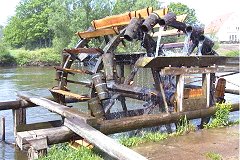 |
|
See the »Kleine Schäferrad« in live action! Four little video sequences recorded in August, 2003 show the running waterwheel from various perspectives. The video files are presented in AVI format for use with one of the usual media players (file size of each video is approx. 3 MB, running time is 20 seconds each). Download: Video 1 , Video 2 , Video 3 , Video 4 . Nowadays, the use of these hand-mad wooden giants can't be justified any more by economic calculations: watering rural grounds by modern motor pumps is much cheaper and more reliable. So it's indeed very honorable that engaged citizens keep this vintage technology alive in our modern age of efficiency. Without their voluntary work, the waterwheels would be forgotten history already! But as it is, these simple but amazing machines will survive and please the eye of any spectator for a long time to come... |
